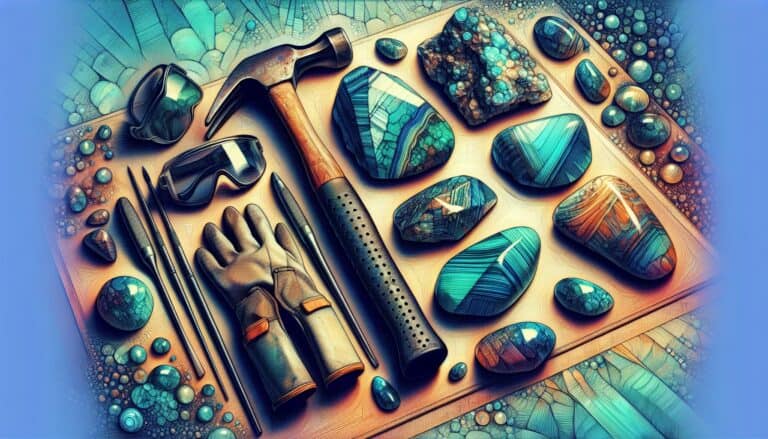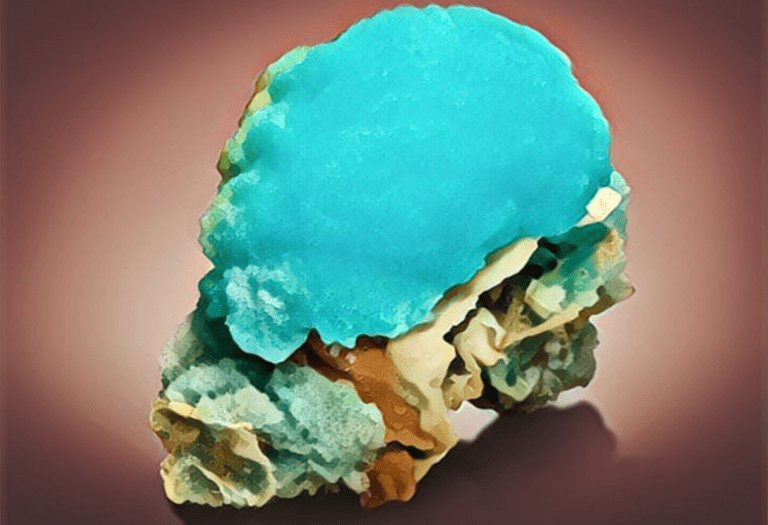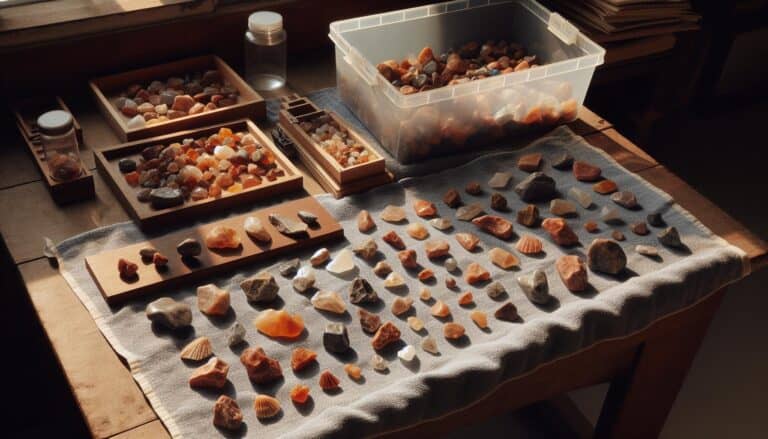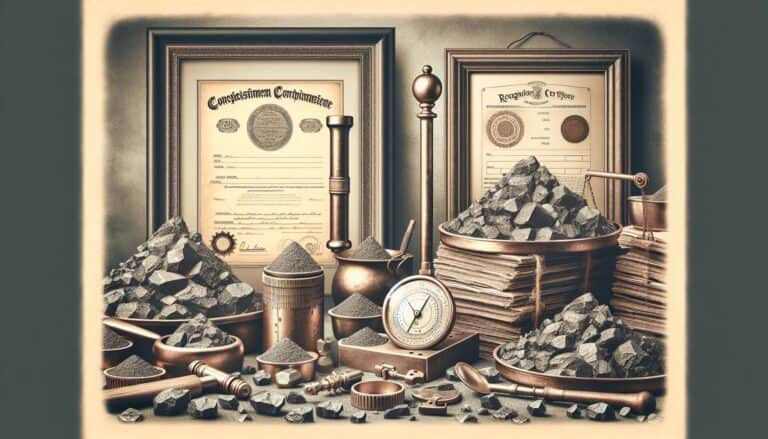Discovering the serene beauty of larimar, a gemstone as captivating as the Caribbean Sea it mirrors, is like uncovering a hidden treasure.
You’re drawn to its unique patterns and soothing blue hues, aren’t you? But with popularity comes imitation, and you’ll want to ensure you’re getting the real deal.
You’re in luck because identifying authentic larimar isn’t as daunting as it seems. It’s all about knowing what to look for. From its distinctive color palette to the subtle interplay of light and texture, recognizing true larimar is an art you can master.
Let’s dive into the nuances that set this gem apart, ensuring you can spot a genuine piece with confidence.
Spot real larimar: blue with white marbling, white streak, non-magnetic, 4.5-5 hardness, single refraction. Find in Dominican Republic. Use hammer, gloves, loupe, backpack, GPS. Prioritize safety: gear, awareness, hydration, communication, first aid. Clean gently, store in soft pouch. Enjoy unique beauty!
How to Identify Larimar Through Testing
Visual Inspection
Begin by examining the gemstone’s color and texture. Authentic larimar will typically have a volcanic blue color that mirrors the sea, with patterns resembling sunlight dancing beneath Caribbean waters. You’re looking for a soft interplay of white and blue, with the white often appearing as marbled streaks. These unique features are challenging to duplicate precisely, which means they’re your first clue in spotting a real piece.
The Streak Test
A streak test can help identify genuine larimar by scratching the stone across an unglazed ceramic plate. The powder left behind should be white. Any other color suggests it’s not larimar, as true larimar doesn’t leave a colored streak.
Magnet Test
Conduct a simple magnet test. Since larimar is not magnetic, if your stone is attracted to a magnet, this is a clear indicator that the gem might be an imitation, possibly containing added iron or other magnetic minerals.
Hardness Test
Larimar has a Mohs hardness of approximately 4.5 to 5. The hardness test involves attempting to scratch the stone with an object of known hardness. A genuine larimar will not be easily scratched by a copper coin (hardness 3), but can be scratched by a pocket knife, typically around hardness 5.5.
Birefringence Test
When viewed under a polariscope, authentic larimar should display birefringence—an optical property where the stone splits a ray of light into two paths. If your larimar demonstrates this effect, it supports its authenticity.
Checking The Diaphaneity
Larimar’s diaphaneity, or transparency to light, should be opaque to translucent. Hold the stone up to light to test its level of transparency. If it’s excessively clear or completely opaque, it may not be true larimar.
Single or Double Refraction
This test involves looking at a line or a dot through the stone. In a genuine larimar, the single line stays intact due to its single refraction quality. Conversely, double refraction will split the line in two, which is not characteristic of larimar.
Refractive Index Test
Professional gemologists determine authenticity through the refractive index, which should be 1.598 to 1.653 for larimar. A refractometer is required for this test, which may not be practical for most individuals.
Finding The Specific Gravity
The specific gravity of larimar ranges from 2.7 to 2.9, which is an identifying property you can test by comparing the weight of your gemstone in air versus its weight in water. Equipment necessary for this includes a scale sensitive enough to measure small differences in weight.
Identifying Larimars in the Field
Spotting larimar in the field requires seeking out serpentinite rock formations, primarily found in the Dominican Republic. Look for stones with a distinct blue hue that stand out against the greenish host rock.
Recognizing Potential Larimar Rocks
When scouring locations where larimar can be found, keep an eye out for rocks with blue coloration. While the surface may appear weathered, an experienced eye will notice the characteristic turquoise-blue color that reveals the potential of larimar beneath.
Physical Characteristics of Larimar
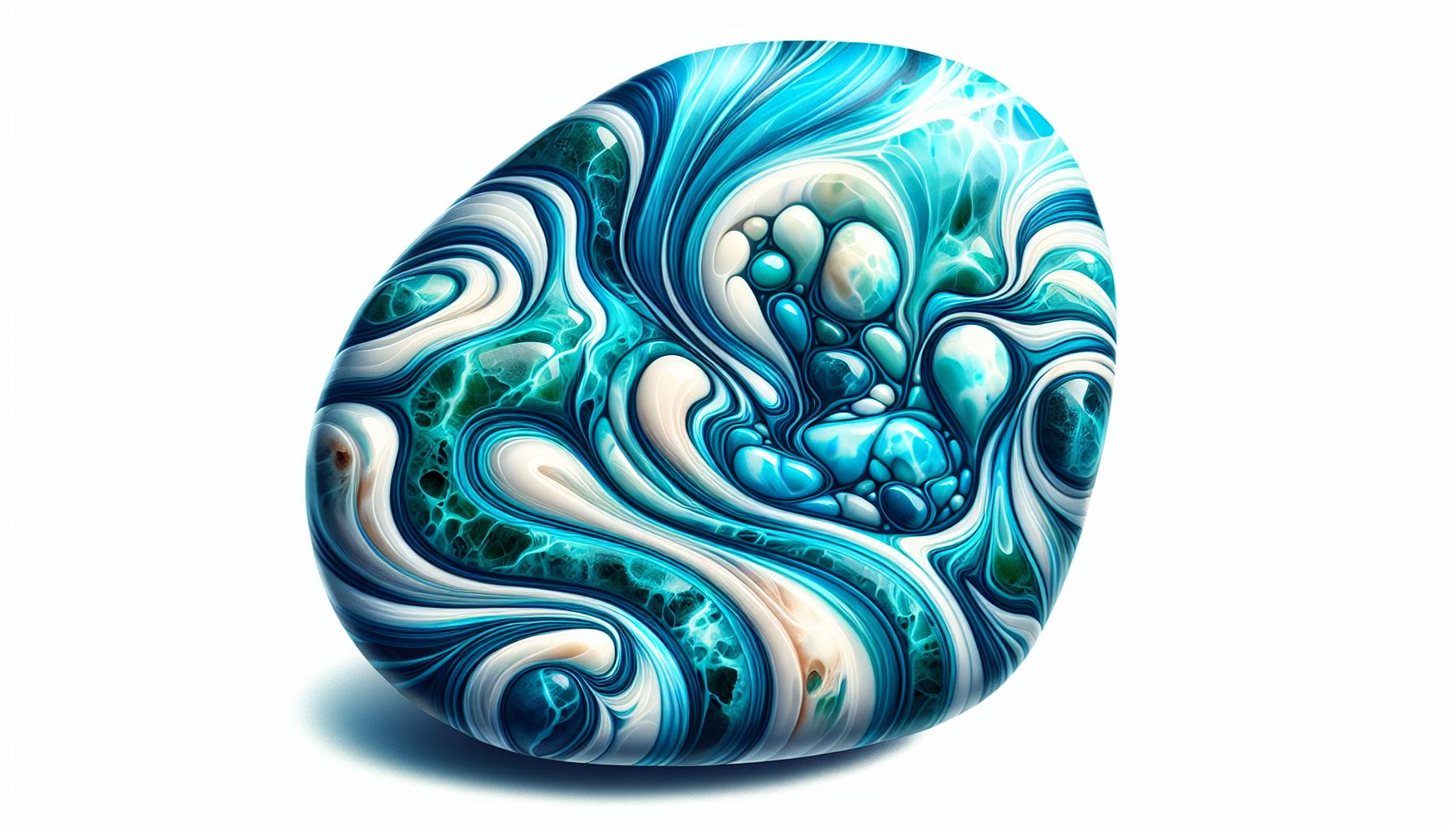
When you’re investigating the authenticity of larimar, you’ll want to pay close attention to its unique physical characteristics. Larimar is not only renowned for its striking blue color but also its noteworthy patterns. Sky blues, turquoise to deep oceanic blues, often mottled with white streaks or patterns, are indicative of true larimar. These hues resemble the Caribbean Sea and are due to the presence of copper within the stone.
Another key characteristic is texture. Authentic larimar has a smooth, glassy feel when touched. It’s a hydrous phosphate mineral, which makes it somewhat tough yet susceptible to heat and acids. The texture can also be described as pectolite, meaning it should have a silky luster. If the stone feels rough, grainy, or overly hard, you might be looking at an imitation.
Let’s talk about weight and heft. Larimar stones have a specific gravity that ranges typically between 2.7 to 2.9. This means that real larimar should feel somewhat heavy for its size. If the stone in question feels suspiciously light, it may be a sign of a counterfeit.
To determine the hardness, remember that larimar scores between 4.5 and 5 on the Mohs hardness scale. It’s sufficiently hard to be used in jewelry but soft enough to be scratched by a knife. Thus, if you can’t make a mark on your specimen with a metal object, its authenticity should be questioned.
Lastly, examine the shape of raw larimar. It generally occurs in nodules or stalactitic masses. You’re unlikely to find perfectly round or square specimens in nature but rather irregular, one-of-a-kind shapes that add to the charm of genuine larimar pieces.
How Are Larimar Formed?
Larimar, also known as “Stefilia’s Stone,” is a rare gemstone that owes its existence to a unique set of geological conditions. Born from the fiery chaos of volcanic activity, larimar is a pectolite mineral, the result of crystallization when hot gases from molten rock push upwards, infiltrating cavities within the basaltic lava. The intense heat and high-pressure environment are crucial for forming larimar’s distinctive blue hue.
During the cooling process, the interaction between minerals such as calcium and sodium along with trace elements like copper imparts the beautiful blue coloration that distinguishes larimar from other types of pectolite. The variations in shading from light blue to deep blue-green are the results of varying concentrations and interactions of these elements.
The regions within the Dominican Republic are the only known source of this blue pectolite, specifically the province of Barahona. This exotic locale is where you’d need to venture if you’re keen on locating this stone in its natural setting. The geological conditions there are uniquely suited to larimar’s creation.
Distinct from other minerals, larimar’s formation process is a complex interplay of volcanic and sedimentary processes that result in its characteristic fibrous texture and hardness that range on the Mohs scale. This unique formation process is also why genuine larimar is limited in supply, as the specific conditions required to create this gemstone are rare and confined to a particular geographic area.
Preparation for Larimar Hunting
Embarking on a larimar hunt is an exciting prospect, but before you dive into the blue, you’ll need to make sure you’re well-prepared. Like any treasure hunting, this requires the right gear, knowledge, and safety measures to ensure a successful and safe adventure.
Gathering the Right Tools
To maximize your chances of finding authentic larimar, it’s essential to equip yourself with the appropriate tools. Here are some of the items you should consider bringing along:
- Geologist’s Hammer: This is crucial for breaking rocks and extracting potential larimar stones.
- Chisels and Goggles: For precision and safety when chipping away at rock formations.
- Gloves: Durable gloves will protect your hands during the digging process.
- Jeweler’s Loupe: A magnifying glass will help you examine stones closely for identification purposes.
- Field Guide: Carry a guide to assist you in distinguishing larimar from other minerals.
- Backpack: You’ll need a sturdy backpack to carry your tools and any stones you might find.
- GPS Device or Maps: Navigate the region with ease, helping you mark and return to promising locations.
Being prepared with the proper tools ensures a streamlined hunting process, saving you time and increasing your potential to strike it rich with a genuine larimar find.
Safety Considerations
Safety should never be an afterthought, especially when hunting for minerals in potentially hazardous environments. Here’s how you can stay safe while on your expedition:
- Wear Protective Gear: Always have your safety goggles, gloves, and steel-toe boots on. These can protect you from flying debris and rough terrain.
- Be Aware of Your Surroundings: Watch for loose rocks, slippery surfaces, and any wildlife that could pose a threat.
- Stay Hydrated: The Caribbean sun can be unforgiving, so keep a water bottle handy to prevent dehydration.
- Inform Someone of Your Plans: It’s vital that someone knows your whereabouts and expected return time in case of emergencies.
- First Aid Kit: Pack a well-stocked first aid kit to address any minor injuries immediately.
With these safety measures in place, you can focus more on the thrill of the hunt and less on the risks. Remember, a safe hunter is a happy hunter. Keep your wits about you as you seek out the elusive blue treasure of the Caribbean.
Handling and Care of Found Larimar

Once you’ve successfully identified and collected larimar stones, it’s crucial to handle and care for them correctly to maintain their natural beauty and value. Proper cleaning and storage techniques will ensure your larimars remain in pristine condition.
Cleaning Larimars
Your first step after finding a larimar is to clean it. Larimars should be treated gently to prevent damage:
- Use a soft brush and mild soap to remove any dirt.
- Rinse the stone with room temperature water. Avoid hot or cold extremes that can cause shock to the gemstone.
- Dry with a soft, lint-free cloth. Do not use abrasive materials that might scratch the stone.
Important: Never use harsh chemicals or ultrasonic cleaners on larimars. They could deteriorate the stone’s quality.
Storing Larimars
Proper storage is as important as cleaning. Here’s how you can keep your larimars safe:
- Store each larimar separately to avoid scratches. Soft pouches or fabric-lined jewelry boxes are ideal.
- Keep them away from drastic temperature changes, humidity, and direct sunlight which can cause color fading.
- For rough stones, a cool, dry box is suitable for preventing any chipping or cracking.
Whether you’re keeping larimars for personal enjoyment or preparing them for sale or trade, remember that they require thoughtful care. Regular upkeep will protect the unique properties and aesthetic of these magnificent blue treasures.
Conclusion: Confirming Larimar is Real
Armed with the knowledge of how to spot genuine larimar and the best practices for its care, you’re now ready to embark on your own larimar hunting adventure.
Remember, the key is to stay vigilant and use the tests and tips you’ve learned to ensure you’re picking the real deal. Once you’ve found your treasure, proper cleaning and storage are crucial for preserving the beauty and integrity of your larimar. Treat them with care, and they’ll remain a stunning piece of the Caribbean for years to come.
Happy hunting, and treasure your unique finds!


